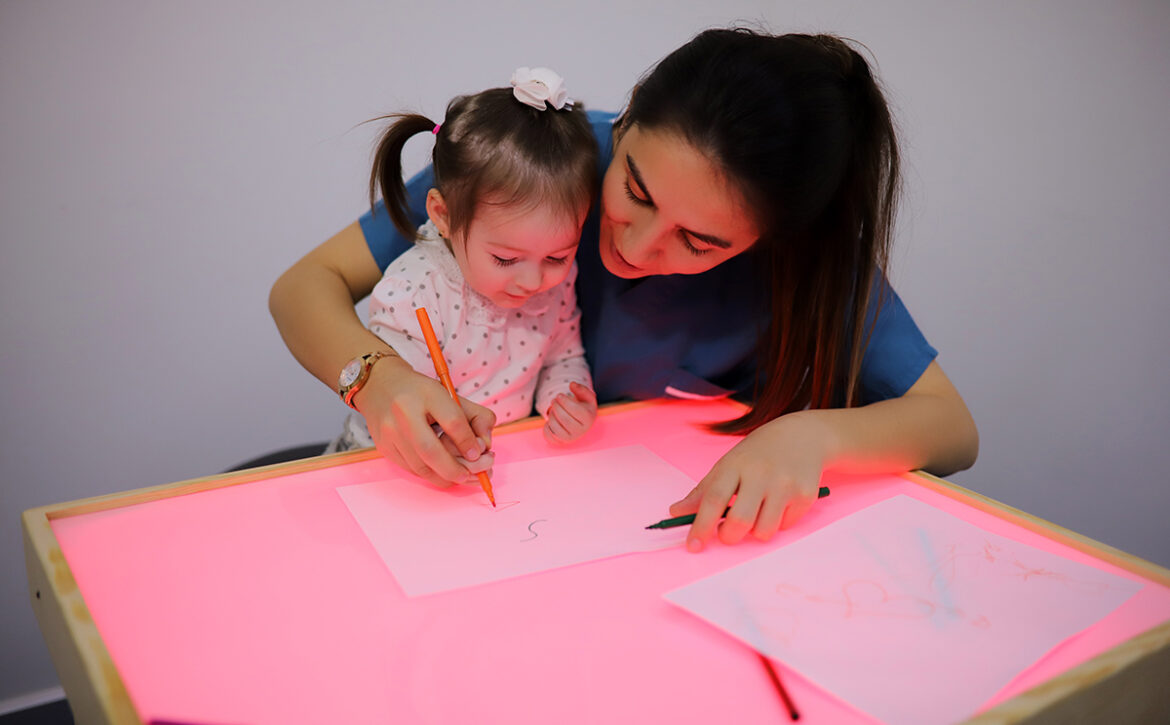SNOEZELEN THERAPY
What is Snoezelen Therapy?
Snoezelen therapy offers a comfortable atmosphere that includes pleasant surroundings, relaxing sounds, enchanting aromas, tactile experiences, massage and vibration, vibrosonic sensations and gentle movement, through multiple sensory environments suitable for all ages and development. Interesting lighting effects and comfortable seating allow one to regulate himself / herself by choosing the senses. Moreover, the Snoezelen environment provides opportunities for communication-interaction and participation.
Who is Snoezelen Therapy Applied to?
- Snoezelen for Premature and Early Period
From the moment we are born, we constantly experience a wide variety of sensory information from the world around us; audible, visual, tactile, olfactory, tasting, vestibular and proprioceptive and interoceptive. Information is fed from our peripheral nervous system to our central nervous system and then we organize a response to inputs. In short, we have to learn how to react to these different stimuli. How we choose to respond will depend on our previous experiences.
Sensory play is not only fun, it is also an essential part of early human development. The more we are exposed to stimulants, the more neural pathways in the brain are established and our response generally becomes more efficient.
- Snoezelen for Behavior Change
If people experience life changes and find it difficult to cope, negative thoughts may develop and emotions can be expressed / reflected in ways society finds difficult to cope with and understand. There are many difficult behaviors involving people chewing and eating, spitting, screaming and shouting, hitting and cursing.
With Snoezelen therapy, when they experience life changes and find it difficult for them to cope, they can build negative thoughts and the emotion can be demonstrated in ways society can have trouble coping and understand.
- Snoezelen and Occupational Therapy
Occupational therapy is a profession that focuses on getting people to do what they want or should do in their lives. It is a fundamental element of clinicians who plan and provide effective care services, as well as defining the individual’s engagement methods, as well as cognitive ability and physical functionality level.
Snoezelen Multi-Sensory Environments (also known as ‘sensory rooms’) provide the user with an interactive space that offers interactive, visual, scented and interactive activities. It can be easily graded to provide appropriate activities for many sensory, cognitive, fine motor and gross motor skill levels.
- Snoezelen for Learning Disabilities
This support area can be quite complex. People may have a wide variety of needs and different diagnoses that affect how they live life, the challenges they face, and the level of support they need. The combination of these very specific needs can affect cognition and / or physical functioning.
Multiple Sensory Settings (MSEs) can provide a space where various interventions can be arranged to accommodate an intervention quickly and easily, whether it is therapeutic, educational or focused on calming, soothing, or using sensory equipment. For example, object recognition and context, as well as the following routing and sequencing activities, may be purposeful targets.
- Snoezelen for Mental Health
We change things around us, both positively and negatively, and we are not always responsible for the control or responsibility of what happens. These things can have a huge impact on how we live and how we feel. Experiencing illness, sudden or prolonged trauma, loss of loved ones, prolonged or restricted functional ability can profoundly affect thoughts, emotions, and our behaviors as we deal with the new situation.
Multi-Sensory Environments (MSEs) can be fully customized to create a safe space for your client to fully relax and be responsive to therapeutic interventions. Snoezelen rooms enable the client or therapist (or both) to create immersive environments where one can feel safe and calm, not feeling threatened.
- Snoezelen for Autism
Snoezelen Multi-Sensory Environments provide a convenient, graded and safe environment for Health and Social Care professionals to evaluate and intervene. Treatment and care should take into account individual needs and preferences, but be flexible enough to respond to changing needs when the individual responds or responds to treatment.
When it comes to supporting and caring for individuals with autism, the physical environment is a vital component of any treatment plan.
Snoezelen Multi-Sensory rooms for autism are individually designed according to user briefings and features. The entire environment can be adapted and rooms can be personalized, graded and adapted to the needs of the individual. Expressive sounds, lighting, videos and products can be tailored to the user’s interests or specific learning goals.
- Snoezelen for Brain Injury
Acquired brain injury and other neurological conditions can harm the person concerned and their families, friends and loved ones, especially if they are the result of a sudden event. Multi-Sensory Environments can perhaps be designed to include equipment that can initially aid in a person’s physical and / or cognitive rehabilitation journey, although this is not a very obvious choice for clinical interventions.
Basically, the room needs to be designed for inclusiveness, so that everyone, regardless of the need for mobility, can access and execute a variety of activities, such as using a walking frame, using a wheelchair, or requiring transfers via mobile or roof-rail lifting platforms. Purposeful design and planning are required to effectively serve the needs of this customer group.
- Snoezelen for the Elderly
The term dementia refers to progressive disorders that affect the brain, such as Alzheimer’s disease, vascular dementia, and Lewy body dementia. These conditions present problems with thinking, mood, behavior, and the ability to take part in daily activity and recreation. Without proper activity and people living with dementia have nothing to do, they can become increasingly isolated, angry, bored, and unhappy.

